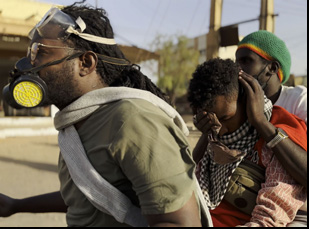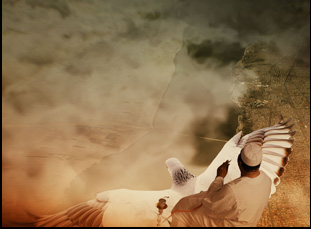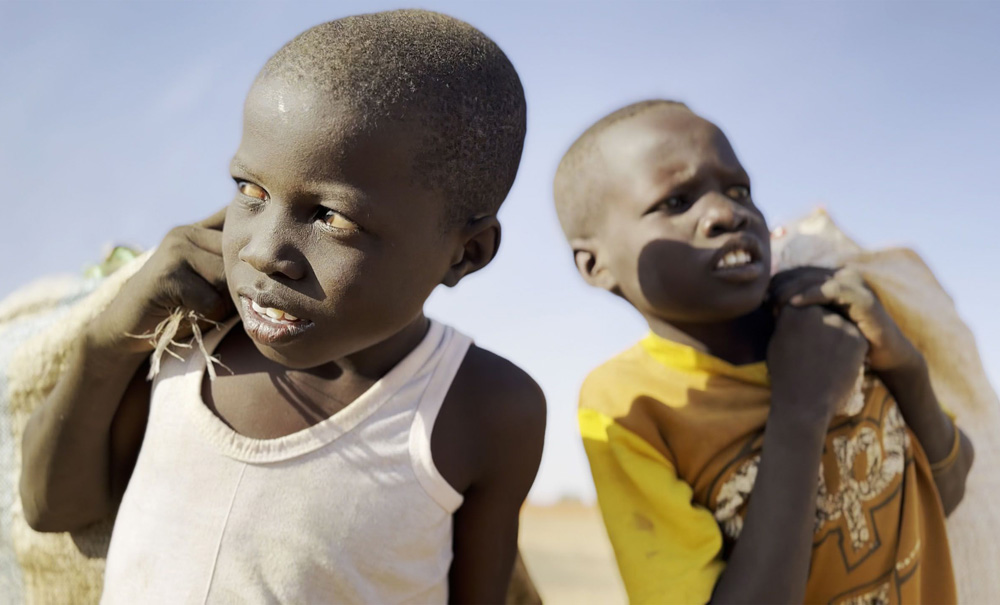There was a moment where it surely seemed like “Khartoum” wouldn’t make it to the screen. Filmmakers Anas Saeed, Rawia Alhag, Ibrahim Snoopy, and Mohamed Ahmed, under the guidance of Phil Cox, had been filming in their homeland before their native Sudan fell into a brutal civil war in April 2023, leading the people they were following for months to flee and following suit when it became too dangerous to stay. However, as the country fell into chaos and a way of life disintegrated by the day, what they had captured seemed more important than when they began to film in the first place, simply collecting footage of everyday life in the region that might be some of the last evidence of life there in relatively peaceful times.
Now that Khartoum can only be accessed by former residents in their memories and dreams, the filmmakers made a bold decision when they were able to reconvene some time after they stopped shooting on the ground in Sudan and undertook the difficult work of reconnecting with the film’s initial participants who were also now scattered to the wind. While travel back wasn’t obviously an option, the filmmakers devised an ingenious workaround, hoisting up a green screen in which everyone involved could project in any number of ways their hopes for their homeland and their most cherished history there that would’ve been difficult to put up on screen before anyway. The result is invigorating as Khadmallah, a tea stall owner, Majdi, a civil servant, Jawad, a resistance committee volunteer and Lokain and Wilson, two boys who scrape by collecting bottles all brighten at the opportunity to reflect on better times and offer a vivid picture of what life in Sudan was like with all of its various social spheres.
Mixing together footage from the ground and recreations of what continues to live in the hearts and minds of its participants, the mosaic quality of “Khartoum” as a production ends up as a mirror of the dynamic place that existed, all held together by a slender thread in the first place and subject to a tight grip now when what’s left is threatened with vanishing for good. But it’s presented as a place of passion, both in celebration and rebellion, and beyond the inventive approach to salvaging what material they had, the filmmakers behind “Khartoum” offer a fresh perspective on a part of the world that is too rarely seen on screen. The film will be premiering on one of the biggest stages possible this week at the Sundance Film Festival and Saeed, Alhag, Snoopy, Ahmed and Cox graciously congregated to discuss how they carried on with a production that looked like it had no path forward, deciding who best could give a sense of the society and their own aspirations for the film.

Phil Cox: Yes, it started in 2021 when I was in Khartoum and met Talal Afifi at the Sudan Film Factory. It became clear that there was a lot of exciting new Sudanese cinema talent, but without access to tech or cameras, so the idea evolved of creating a cinematic poem in Khartoum with young emerging new talent, Sudanese filmmakers. We got a small workshop grant to begin that in Khartoum.
Ibrahim Snoopy: Rawia [Alhag], myself and other filmmakers were initially selected for that workshop about how we could tell the stories with emotions and feeling, led by Phil and Talal and Joe. And we started to shoot each story on its own, starting with Anas [Saeed] and then Rawia, then me. But then just when we were about to get the last pickup shots for the film right after Ramadan, that’s when the war happened on the 15th of April. Then we couldn’t finish the movie and we had to shift the story because we had to link it somehow to the war.
We lost contact with the participants we followed for a few months because of the war and there’s no internet connection. They were difficult to access due to the factors of the war, and it was very difficult to reach out to them without risking our lives. Then we all came to Nairobi and we did a series of workshops, also led by Phil, brainstorming on how to continue this film after losing hope for a few months. We went through the script and thought about what we can do in a creative way to tell these stories without getting away from the original story. We tried to experiment with a lot of things. We did green screen, we did intimate interviews with the characters, dreamscape sequences and we came up with this weird mix. We wanted to do something different. We had old footage of Khartoum and that was the last footage of anyone filmed there and we mixed it with some green screen and interviews, and we came up with this crazy creative film.
It’s really wonderful. When this started out with following a certain participant, what led you to the people you followed?
Anas Saeed: My participant Khadmallah was a tea lady and I’m a regular customer at her place. I saw the resilience and the strength of her being a single mom and also surviving under these difficult circumstances in Sudan. She’s well-educated and part of the Khartoum resistance, fighting against the oppression of the system. Also, it’s part of the culture in Sudan to have tea ladies around the corner and people refer to them for many reasons. Some people do deals at the tea lady’s or trade money. Some people also use it as an outlet to express their feelings. You feel relieved when you go to a tea lady and drink some tea, so we created a bond together — to the point where I’m no longer just another customer. I’m like family to her. If you have money or don’t have money, you go there and you get anything you need.
Rawia Alhag: There are many kids in Khartoum that do the same profession as Lokain and Wilson in the film, but it was very hard for me to find them because in Khartoum, it’s not usual to shoot a film with them. Every day I was roaming around to find some kids and also secure the approval from their families and from them to make a film. For three months, I was looking for such partners. And everyone I was approaching assumed that I was not trustworthy [since filmmakers aren’t] a known thing. It’s an unusual profession. At the moment I lost hope, Anas helped me find the participants, who are the cousins of a friend of Anas’ that became my ultimate partners.
Phil Cox: The directors had extraordinary relationships with their participants, and what both represent behind the camera and in front is a real diversity in Sudan. It is also what fueled the war, when Sudanese history is about separation, ethnic diversity, divide and rule. But this film really shows an inclusivity and harmony that is pretty extraordinary for Sudan. My job was just to keep an overview and try and make this into a complete film while each director’s job was just to emotionally burrow deep with their participant, so each director just worked on their single story and remember, they all had just escaped war. They literally lost everything, both directors and participants, so it was a traumatized group when they came to Kenya and with the participants, the Sudanese team [of filmmakers] decided that now was the time to come together and continue and complete this story and that this documentary had a different value than the first one that we presumed. The war was destroying memories, destroying a city and a whole generational relationship with the space, and they realized that what they’d filmed before the war had this immense value.
But we had to consider how could we make this into a story that went forward when we had nothing. We had no escape footage after the war started, but as a team, myself and the directors realized that actually inside each of our characters was their escape, so each director worked with [the person they had been filming with already] to create something we call a “Dreamscape” or “dream reversion,” where we would make the character go back to the spaces they had in Khartoum and re-dream being there. That’s the voiceovers you hear and the reconstructions on the green screen. We didn’t know if it was going to work, but this was participatory filmmaking and it couldn’t have happened otherwise. And what you don’t see is the directors also performed and reconstructed their own moments for the participants to explain to them how this is going to work. So each director gave their own traumatic moments, their own experiences to show Lokain and Wilson, to show Khadmallah, to show Jawad, what you have to give in front of the camera for the film to work.
And I came along for the ride, but it was a real honor to be with this group who are the future of filmmaking in Sudan. They’re fearless, and that’s something I don’t say lightly because I worked there for a long time.

Ibrahim Snoopy: To me, it was very important to reflect the participants’ emotions and how they wanted their life to be — their dreams, their ambitions, their hopes, and all of those things, because the war destroys everything that you build throughout your whole life. For example, Jawad wanted to be a superstar. The kids wanted to have a good education. We wanted them to tell their stories and also what do you wish for, and then we were reflecting that in a creative way. We wanted them to give their experience of the war, but also not just the traumatizing side, but also their dreams because that’s also part of being human. You have your ups, you have your downs, and that’s what’s unique about this film, is that it’s not another film about war and devastation, but also it’s about the hopeful side. For all of us, it was essential to reflect that on screen.
Rawia Alhag: Yeah, we wanted to show Khartoum through 10 eyes, five different people from different cultures in Sudan, which is very diverse, and also show that they’re from different generations. They are diverse in many ways, and we wanted to show Khartoum through their eyes and through their senses.
Timeea Mohamed Ahmed: Yes, it’s not just a sad story from Africa. It shows happy people in the most cursed situations — people, as Snoopy said, with dreams, big ones. And it shows the complexity of Sudan and in this film process, it showed that people can work together and operate as a family from different parts of Sudan and it meant a lot to show Khartoum, the city I love the most, through very interesting and very diverse characters.
Anas Saeed: For me, I wanted to show the strong women in Sudan, both resilient and resistant, and also the culture [with such aspects as] Sufi dancing, which are very beautiful.
Phil Cox: And for me, it was important what they said they didn’t want, which was for this to be a traditional visual narrative of reportage, of street violence and drama showing them as victims or [this being] another African crisis. They wanted the freedom of cinema to be bold and try something new, so we really went through many things, but that’s why they turned to this format. Cinematically, everybody chose this other way and the way they shot and the way they created that is the reason for it.
“Khartoum” will screen at the Sundance Film Festival on January 27th at 2:45 pm at the Egyptian Theatre, January 28th at 8:50 pm at the Megaplex Redstone, January 29th at 2:45 pm at the Broadway Centre Cinemas in Salt Lake City, January 31st at 12:15 pm at the Holiday Village Cinemas. It will also be available online from January 30th through February 2nd via Sundance’s virtual platform.




